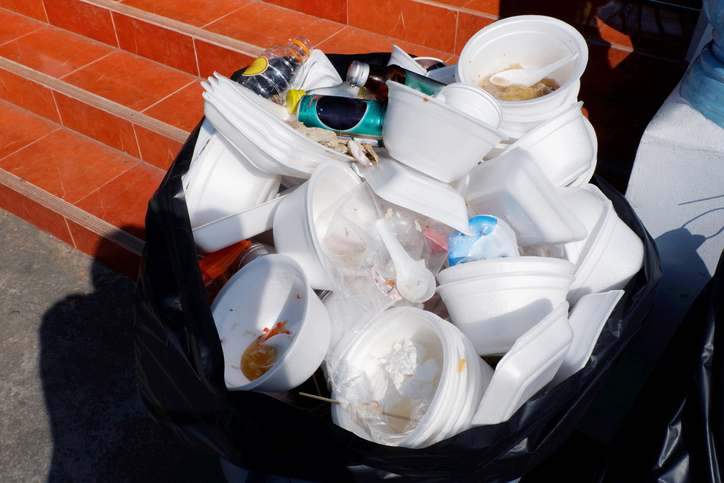Delivering Sustainability in Good Taste While Removing Last Mile Waste
First of a two-part series

Drive through urban centers and surrounding suburbs, and you’ll see visible clues of consumer behaviors along the curbsides and overflowing trash bins: vivid displays of last mile waste.
From cardboard, corrugated fiberboard and plastic to bubble wrap, foam and throw-away utensils — many are remnants of recent restaurant-cooked meals. The more a “disposable” mentality is embraced, the stronger the cries from sustainability advocates.
With the advent of e-commerce and logistics giant Amazon and its partnering retailers, people have grown accustomed to finding product and receiving it, within 24 hours or less. The operational models and financial pockets of small-to-midsize local businesses cannot compete.
A double-edged problem lies in last mile delivery: the need to align environmentally supportive practices while meeting consumer demands. Two companies are working together to take on that challenge and change the ecosystem of localized food service and last mile delivery.
The Fork in The Road
Over the last 10 years, there has been a rise in consumer convenience culture, says Lauren Sweeney, founder of DeliverZero, a New York-based zero-waste solutions provider bringing reusable and sustainable containers to food service companies.
Although supply chains account for high amounts of greenhouse emissions, there remains some reluctance to take sustainability initiatives seriously, she says. Sweeney has found that organizations in the past tended to task marketing managers or junior associates with their sustainability efforts without providing assistance, product support or budget. Today, with municipal, state and federal regulations on plastics and packaging in place and growing, the C-suite is rethinking its part in the ecosystem, she says.
For restaurants in New York, for example, the pressure for change is imminent. “One bill that may be presented would mandate instituting a reusable package option for food service companies at all points of sale,” Sweeney says. The regulation would apply to restaurant chains with at least 10 corporate-owned locations. Franchisees that fall below the 10-location threshold are considered a small business not covered under the proposed regulation; however, there are exemptions.
A person who owns 10 locations under a corporation or a limited liability company can be included in the bill’s provisions. Amid this legislative process, she says, there is sensitivity toward small businesses.
Greener business practices continue to make their way toward a more sustainable future for shipping and logistics companies, says Michelle Saks, COO of Gently, an eco-conscious, nano-fulfillment logistics provider.
The last-mile delivery company has sought to create a same-day delivery solution for brands and retailers that they could promise as a standard. Saks says that by moving from a larger carrier base to the nano-fulfillment model, small businesses can avert delays and disruptions from industry trends including labor strikes and regulatory stressors.
The Wake-Up Call, Answered
Ensuring last-mile delivery systems align with laws and regulations is much like monitoring a moving target, says Saks. Staying apprised of federal, county and city-specific ordinances is necessary as (1) changes to municipal codes, (2) allowable curbside access, (3) size of delivery vehicle and (4) public commentary made to government officials during city council meetings can affect the localized logistics model.
“If you don’t pay attention to the details, it can be a costly wake-up call,” she says.
It starts with the packaging, which for DeliverZero, is a material that is lightweight, durable and a non-conductor of heat. For food service providers, the product brings restaurants added convenience and efficiency as containers stack easily and are unbreakable when dropped. Another benefit: DeliverZero reusable packaging can be monetized with each use, adding another competitive layer against single-use products.
Packaging Expectations
DeliverZero gauges their business in two ways, by: (1) focusing on getting product easily into its customers hands and (2) making the most out of every mile traveled by leveraging empty courier legs through driver collection of unused packaging and e-commerce returns at the customer’s door and other designated pickup locations.
“Many brands cannot afford to build out a logistics apparatus providing that elevated level of speed, convenience and cost efficiency without relying on someone else who will cut into their customer base or margins,” Saks says. “With DeliverZero, we were able to expand into new markets.”
The baseline of the package delivery system is depressingly low, Saks says. “If a consumer receives a package that isn’t warped, broken or in the neighbor’s yard, it’s celebrated,” she says. “We all deserve better than that. Our delivery system must matter from a cost-efficiency perspective and from a people perspective.”
By partnering with Gently, Sweeney states that business optimization occurred through bilateral technology integration. “Our new restaurant partners in Los Angeles receive packaging on the same day through Gently delivery. From the moment a customer engages our service, onboarding often happens in under 24 hours.”
By the time a food service provider receives their DeliverZero plug in, a system-generated “what to expect” communication process begins, she says: “It’s seamless and scalable, allowing our customers to keep their focus on serving their own customers.”
Cleaner Consumption
DeliverZero makes reusables available through the food service channels consumers already use, such as restaurant counters and ordering apps DoorDash, Uber Eats and others that don’t require a change in human behavior. Through their Gently partnership, customers also receive simple, reusable package return options creating opportunities that support sustainability full circle.
“Once this scales across the board and becomes the norm for both businesses and customer consumption, the practice will become second nature, much like recycling that’s been around for decades,” Sweeney says.
The second part of this series, slated for the January 16 Inside Supply Management® Weekly, covers how tracking algorithms provide real-time driver and customer metrics, showing the impact of sustainability efforts and how product return options instill greater consumer engagement, social consciousness and more.


